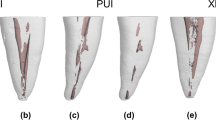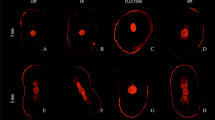Abstract
Objective
The objective of this study is to evaluate the influence of a calcium hydroxide intracanal dressing (CH) on the short- and long-term sealing ability of the root canal filling using capillary flow porometry (CFP).
Materials and methods
To verify the repeatability of the method, five obturated specimens were submitted to CFP. Measurements were repeated three times and compared with the non-parametric Friedman test. Forty-five instrumented palatal roots were randomly divided into three groups. Group 1: specimens were obturated in one step without placement of any dressing. Group 2: CH was placed and removed after 1 week with syringe irrigation before obturation. Group 3: CH was placed and removed after 1 week with ultrasonic activation before obturation. CFP measurements were conducted at 1 week and 6 months after obturation. The inter-group comparisons were performed using the Kruskal-Wallis test and the intra-group comparison over time using the Wilcoxon signed-rank test. Significance level was set at 0.05.
Results
In the five specimens, no difference could be detected between the consecutive measurements for minimum, mean flow, and maximum pore diameter indicating repeatability of the method. No difference in sealing ability could be detected neither between the 3 groups at 1 week and at 6 months nor within each group between the 1 week and the 6 months measurements.
Conclusions
Placement of a CH did not affect significantly the short- and long-term sealing ability of the root canal filling.
Clinical relevance
The use of an intermediary CH does not negatively influence the quality of the root canal filling.
Similar content being viewed by others
References
Sjogren U, Figdor D, Persson S, Sundqvist G (1997) Influence of infection at the time of root filling on the outcome of endodontic treatment of teeth with apical periodontitis. Int Endod J 30:297–306
Ng YL, Mann V, Rahbaran S, Lewsey J, Gulabivala K (2008) Outcome of primary root canal treatment: systematic review of the literature—part 2. Influence of clinical factors. Int Endod J 41:6–31
Cailleteau JG, Mullaney TP (1997) Prevalence of teaching apical patency and various instrumentation and obturation techniques in United States dental schools. J Endod 23:394–396
Wu MK, van der Sluis LWM, Ardila CN, Wesselink PR (2003) Fluid movement along the coronal two-thirds of root fillings placed by three different gutta-percha techniques. Int Endod J 36:533–540
Peng L, Ye L, Tan H, Zhou XD (2007) Outcome of root canal obturation by warm gutta-percha versus cold lateral condensation: a meta-analysis. J Endod 33:106–109
Borges RP, Sousa-Neto MD, Versiani MA, Rached-Junior FA, De-Deus G, Miranda CE et al (2011) Changes in the surface of four calcium silicate-containing endodontic materials and an epoxy resin-based sealer after a solubility test. Int Endod J 45:419–428
Shokouhinejad N, Sharifian MR, Jafari M, Sabeti MA (2010) Push-out bond strength of resilon/epiphany self-etch and gutta-percha/AH26 after different irrigation protocols. Oral Surg Oral Med Oral Pathol Oral Radiol Endod 110:e88–e92
Shokouhinejad N, Sabeti M, Gorjestani H, Saghiri MA, Lotfi M, Hoseini A (2011) Penetration of epiphany, epiphany self-etch, and AH plus into dentinal tubules: a scanning electron microscopy study. J Endod 37:1316–1319
Fisher MA, Berzins DW, Bahcall JK (2007) An in vitro comparison of bond strength of various obturation materials to root canal dentin using a push-out test design. J Endod 33:856–858
Sathorn C, Parashos P, Messer HH (2005) Effectiveness of single- versus multiple-visit endodontic treatment of teeth with apical periodontitis: a systematic review and meta-analysis. Int Endod J 38:347–355
Sathorn C, Parashos P, Messer H (2007) Antibacterial efficacy of calcium hydroxide intracanal dressing: a systematic review and meta-analysis. Int Endod J 40:2–10
van der Waal SV, van der Sluis LWM (2012) Potential of calcium to scaffold an endodontic biofilm, thus protecting the micro-organisms from disinfection. Med Hypotheses 79:1–4
Wiseman A, Cox TC, Paranjpe A, Flake NM, Cohenca N, Johnson JD (2011) Efficacy of sonic and ultrasonic activation for removal of calcium hydroxide from mesial canals of mandibular molars: a microtomographic study. J Endod 37:235–238
Calt S, Serper A (1999) Dentinal tubule penetration of root canal sealers after root canal dressing with calcium hydroxide. J Endod 25:431–433
Ricucci D, Langeland K (1997) Incomplete calcium hydroxide removal from the root canal: a case report. Int Endod J 30:418–421
van der Sluis LWM, MK W, Wesselink PR (2007) The evaluation of removal of calcium hydroxide paste from an artificial standardized groove in the apical root canal using different irrigation methodologies. Int Endod J 40:52–57
Kontakiotis EG, MK W, Wesselink PR (1997) Effect of calcium hydroxide dressing on seal of permanent root filling. Endod Dent Traumatol 13:281–284
Caliskan MK, Turkun M, Turkun LS (1998) Effect of calcium hydroxide as an intracanal dressing on apical leakage. Int Endod J 31:173–177
Wang CS, Debelian GJ, Teixeira FB (2006) Effect of intracanal medicament on the sealing ability of root canals filled with resilon. J Endod 32:532–536
Rechenberg DK, De-Deus G, Zehnder M (2011) Potential systematic error in laboratory experiments on microbial leakage through filled root canals: review of published articles. Int Endod J 44:183–194
De Bruyne MA, De Bruyne RJ, De Moor RJ (2006) Capillary flow porometry to assess the seal provided by root-end filling materials in a standardized and reproducible way. J Endod 32:206–209
Hong ST, Bae KS, Baek SH, Kum KY, Lee W (2008) Microleakage of accelerated mineral trioxide aggregate and Portland cement in an in vitro apexification model. J Endod 34:56–58
De Bruyne MA, De Moor RJ (2009) Long-term sealing ability of resilon apical root-end fillings. Int Endod J 42:884–892
De Bruyne MA, De Bruyne RJ, De Moor RJ (2005) Longitudinal study on microleakage of three root-end filling materials by the fluid transport method and by capillary flow porometry. Int Endod J 38:129–136
Faul F, Erdfelder E, Buchner A, Lang AG (2009) Statistical power analyses using G*Power 3.1: tests for correlation and regression analyses. Behav Res Methods 41:1149–1160
Young T (1805) An essay on the cohesion of fluids. Philos Trans R Soc Lond 95:65–87
De Bruyne MA, De Bruyne RJ, De Moor RJ (2006) Long-term assessment of the seal provided by root-end filling materials in large cavities through capillary flow porometry. Int Endod J 39:493–501
Bottcher DE, Hirai VH, Da Silva Neto UX, Grecca FS (2010) Effect of calcium hydroxide dressing on the long-term sealing ability of two different endodontic sealers: an in vitro study. Oral Surg Oral Med Oral Pathol Oral Radiol Endod 110:386–389
Özok AR, Verhaagen B, Wesselink PR (2013) Improving the accuracy of a fluid transport model. Int Endod J 46:348–354
Michiels R, Vergauwen TE, Mavridou A, Meire M, De Bruyne M, De Moor RJ (2010) Investigation of coronal leakage of root fillings after smear-layer removal with EDTA or Nd :YAG lasing through capillary-flow porometry. Photomed Laser Surg 28(S2):43–50
De-Deus G, Namen F, Galan (2008) Reduced long-term sealing ability of adhesive root fillings after water-storage stress. J Endod 34:322–325
Santos J, Tjaderhane L, Ferraz C, Zaia A, Alves M, De Goes M et al (2010) Long-term sealing ability of resin-based root canal fillings. Int Endod J 43:455–460
Wu MK, Fan B, Wesselink PR (2000) Diminished leakage along root canals filled with gutta-percha without sealer over time: a laboratory study. Int Endod J 33:121–125
Donnelly A, Sword J, Nishitani Y, Yoshiyama M, Agee K, Tay FR et al (2007) Water sorption and solubility of methacrylate resin-based root canal sealers. J Endod 33:990–994
Mott PH, Roland CM (2009) Limits to Poisson’s ratio in isotropic materials. Physic Rev B 80:132104. https://doi.org/10.1103/PhysRevB.80.132104
Funding
The work was supported by the Department of Operative Dentistry and Endodontology of the Dental School of Ghent University in Ghent, Belgium.
Author information
Authors and Affiliations
Corresponding author
Ethics declarations
Conflict of interest
The authors declare that they have no conflict of interest.
Ethical approval
All procedures performed in studies involving human participants were in accordance with the ethical standards of the institutional and/or national research committee and with the 1964 Helsinki declaration and its later amendments or comparable ethical standards.
Informed consent
Informed consent was obtained from all individual participants included in the study.
Rights and permissions
About this article
Cite this article
Moinzadeh, AT., De Moor, R.J.G. & De Bruyne, M.A.A. Influence of a calcium hydroxide-based intracanal dressing on the quality of the root canal filling assessed by capillary flow porometry. Clin Oral Invest 22, 1733–1739 (2018). https://doi.org/10.1007/s00784-017-2267-z
Received:
Accepted:
Published:
Issue Date:
DOI: https://doi.org/10.1007/s00784-017-2267-z




